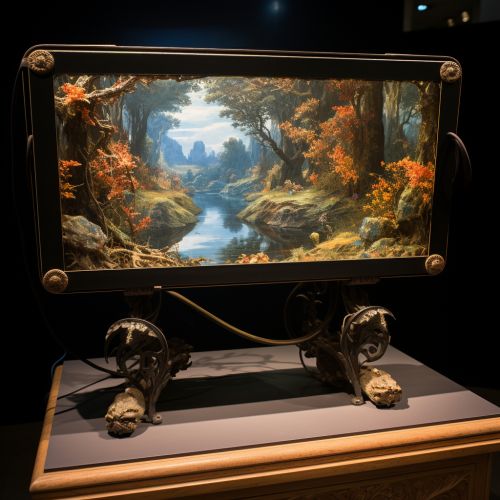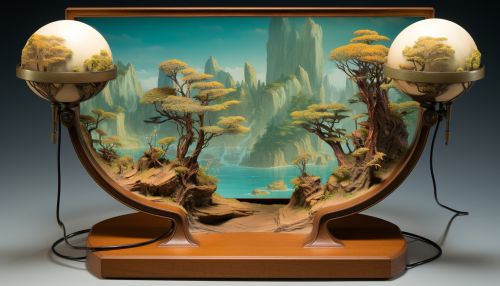Stereoscopic Displays
Introduction
Stereoscopic displays, also known as 3D displays, are a type of display technology that provides a three-dimensional visual experience to the viewer. They achieve this by presenting a slightly different image to each eye, creating an illusion of depth and allowing the viewer to perceive the image as three-dimensional. This technology has been widely used in various fields, such as entertainment, medical imaging, scientific visualization, and virtual reality.
History
The concept of stereoscopic displays dates back to the 19th century, with the invention of the stereoscope. This device used two slightly different images, viewed side by side through a pair of lenses, to create a sense of depth. The stereoscope was a popular form of entertainment in the Victorian era, and it laid the foundation for the development of modern stereoscopic displays.
In the 20th century, the development of anaglyph 3D and polarized 3D systems brought stereoscopic technology to the cinema. These systems used glasses with different colored or polarized lenses to filter the images for each eye, creating a 3D effect.
With the advent of digital technology in the late 20th and early 21st centuries, stereoscopic displays have become more sophisticated and widespread. Today, they are used in a variety of applications, from 3D movies and television to virtual reality headsets and advanced medical imaging systems.


Principles of Operation
Stereoscopic displays operate on the principle of stereopsis, which is the process by which the human brain perceives depth in a visual scene. This is achieved by presenting a slightly different image to each eye, which the brain then combines into a single, three-dimensional image.
There are several methods for creating these different images, including anaglyph, polarized, and active shutter systems. Each of these methods has its advantages and disadvantages, and the choice of method depends on the specific application and the desired quality of the 3D effect.
Types of Stereoscopic Displays
There are several types of stereoscopic displays, each with its unique characteristics and applications.
Anaglyph 3D
Anaglyph 3D displays use glasses with lenses of two different colors, usually red and cyan. The display shows two overlaid images, each filtered through a different color. When viewed through the glasses, each eye sees only one of the images, creating a 3D effect. This method is simple and inexpensive, but it can result in color distortion and a less immersive 3D experience.
Polarized 3D
Polarized 3D displays use glasses with polarized lenses, which filter light waves in different directions. The display shows two images, each polarized in a different direction. When viewed through the glasses, each eye sees only one of the images, creating a 3D effect. This method provides a better color experience than anaglyph 3D, but it requires a special polarized display and can be more expensive.
Active Shutter 3D
Active shutter 3D displays use glasses with liquid crystal lenses that can rapidly alternate between opaque and transparent states. The display alternates between showing the image for the left eye and the image for the right eye, and the glasses synchronize with the display to ensure that each eye sees only the appropriate image. This method provides a high-quality 3D experience, but it requires more complex and expensive equipment.
Autostereoscopic 3D
Autostereoscopic 3D displays, also known as glasses-free 3D displays, use optical techniques such as lenticular lenses or parallax barriers to direct different images to each eye. This method provides a 3D experience without the need for glasses, but it has limitations in terms of viewing angles and image quality.
Applications
Stereoscopic displays have a wide range of applications in various fields.
Entertainment
In the entertainment industry, stereoscopic displays are used to enhance the viewing experience in movies, television, and video games. They provide a more immersive experience by adding a sense of depth to the visual content.
Medical Imaging
In the field of medical imaging, stereoscopic displays are used to visualize complex anatomical structures in three dimensions. This can aid in diagnosis and treatment planning, as well as in surgical procedures.
Scientific Visualization
In scientific visualization, stereoscopic displays are used to represent complex data sets in three dimensions. This can help researchers to better understand and interpret the data.
Virtual Reality
In virtual reality, stereoscopic displays are used in headsets to provide a fully immersive 3D experience. They allow the user to feel as if they are inside a virtual environment, enhancing the realism and interactivity of the experience.
Future Developments
The field of stereoscopic displays is continually evolving, with ongoing research and development aimed at improving the quality of the 3D experience and expanding the range of applications. Future developments may include advances in glasses-free 3D technology, improvements in image quality and viewing angles, and the integration of 3D displays with other technologies such as haptic feedback and motion tracking.
